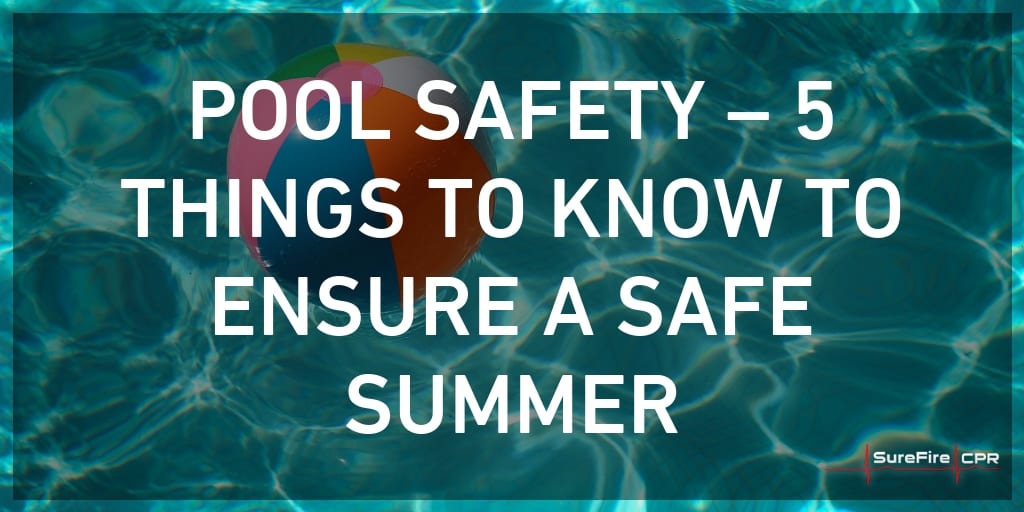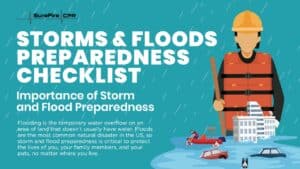With the summer season in full effect, everyone is looking to cool off. While some prefer shade and others crave icy snacks, perhaps the most popular of all cooling-off solutions is the pool. Relaxing, refreshing, and a whole lot of fun, pools are a great place to submerge and spend the hot summer days. However, pools also pose a number of safety risks — especially for those who are unprepared. Atop this list of safety risks is drowning, which can happen in a matter of seconds in pools of any depth. To minimize the risk of drowning and ensure that everyone stays safe at the pool this summer, learn proper safety protocol to prepare for your next pool outing. In this guide, we’ll show you how. Take the following 5 steps to prepare your pool, yourself, and those around you for pool safety, and make this summer the safest one yet!
1. Learn CPR
To fully ensure a safe summer at the pool, it’s important to prepare for even the worst-case scenarios. In the event that a child or individual does lose consciousness in the water, knowing how to perform CPR (short for cardiopulmonary resuscitation) can mean the difference between life and death. CPR is a short procedure that combines chest compressions with direct mouth-to-mouth ventilation to preserve brain function in the short term until further measures are taken. CPR can be performed by anyone, and it can more than double a victim’s chance of survival.
To learn how to properly perform CPR, it’s an excellent idea to take a CPR class. While the skills needed to master CPR are relatively simple, in-person instruction from a trained professional can make a huge difference in the quality of CPR administered. Taking a CPR class will enable you to hone your CPR technique, practice alongside certified professionals, and earn a certification and skillset that can be applied in a myriad of emergency situations. After completing a CPR class, you will know how to administer CPR to adults, children, and infants — essential for ensuring pool safety, no matter who’s at the pool. Can’t come to the pool to supervise your kids? To keep them safe even when you’re not around, make sure that your babysitter or chaperone is CPR and first aid certified.
2. Never Leave a Child Unattended
Drowning can happen in seconds, and it often occurs without a sound. For these reasons, it is extremely important to keep a close eye on swimming children. Even at public pools, where lifeguards are always on duty, an extra set of eyes (or several) can alert lifeguards and other adults to danger much faster. In the event of a drowning accident, seconds saved can mean a life saved. The next time you go to a pool, designate a “water watcher” whose sole job is to watch kids while they swim. (This is especially important at pools without lifeguards.) A final note: make sure that your water watcher is actually watching the pool. That means no TV, no books, and definitely no phone. Just watching.
3. Take Swim Lessons
Though this tip applies primarily to children, knowing how to swim is an essential skill for people of all ages. If you are an adult and you don’t know how to swim, don’t be afraid to take swim lessons. They will make being in water much more fun, and they may one day save your life. Swim lessons will not only teach you how to swim, but they will also help you learn what to do in an emergency or inclement conditions in water. Becoming a stronger swimmer will also better equip you to help others who may be struggling.
Swim lessons are especially important for children, who are the most at-risk for accidents in the water. As nobody is born knowing how to swim, and swimming is not something that can be learned from television or books, every child should take swim lessons. During swim lessons, children will learn the most common swimming strokes, proper breathing techniques, and how to stay afloat in water. Conducted in water, swim lessons also help children become more comfortable in pools and natural bodies of water. Many experts advocate starting swim lessons as early as possible, as children are generally less apprehensive as infants and toddlers. Some of today’s pools and swim centers offer lessons that teach infants and toddlers how to roll on their backs and float in case of an accident.
4. Install Pool Fences and Covers
An unsupervised pool is an unsafe place — especially for kids. If you’re like most parents and pool owners, you won’t let anyone into the pool if there isn’t a lifeguard on duty or adult standing watch. However, sometimes kids have other ideas. During the summer, many kids try to go swimming alone, either by sneaking into pools when owners aren’t watching or by breaking in when nobody’s home. One excellent way to stop either of these situations from occurring is to physically safeguard your pool. Protect your pool and the area around it with a tall fence that is difficult to climb and see over. This will dissuade potential pool hoppers from paying a surprise visit to your pool. Your pool fence should also lock securely and self-close so no one can simply slip through the gate after hours.
Fences aside, pool covers are perhaps the most important pieces of pool protection equipment. Not only do pool covers keep pools clean — they also provide a barrier that stops children, grandparents, pets, (and yes, even infallible adults) from falling into pools when they’re not in use. Typically made from a strong vinyl material, a pool cover is a great investment for both safety and pool maintenance. Just make sure to remove it completely when your pool is in use. A partially deployed pool cover can pose a major drowning risk by trapping swimmers under water. Always remove your pool cover completely before opening your pool.
5. Remove Toys from the Pool After Swimming
Pool toys may not seem like a safety hazard, but they can be one of the biggest risks to small children near pools. Floating pool toys can tempt babies, toddlers, and young kids, many of whom will try to reach for these toys as they float. If this happens when a child is unsupervised, he or she can easily fall into the pool and possibly drown. To avoid this situation altogether, remove toys from the pool after swimming to remove temptation. This will help reduce the likelihood of “falling-in” accidents at your pool.
Learn More and Schedule CPR Lessons With SureFire CPR
With pool season fast approaching, it’s important to take the necessary steps to ensure that all swimmers stay safe. Pool time should be fun and relaxing, and with the proper preparation, it can be. Assigning a water watcher, enrolling yourself and your child in swim lessons, obtaining a CPR certification, and safeguarding your pool are some of the most important pool safety tips you can take to ensure a great summer for everyone. Stay comfortable in the water, and keep those around you safe with these tips. Happy swimming!
Did you find the above article useful? If so, for more information or to get a CPR certification, please visit us at https://surefirecpr.com or call us at 888-277-3143.. SureFire CPR currently offers CPR classes in Orange County, Los Angeles County, San Diego County, San Francisco, Riverside County, and the Inland Empire.
Zack Zarrilli is a Firefighter and the owner of SureFire CPR. His company is comprised of Firefighters, Paramedics, Lifeguards, and EMTs who teach hundreds of CPR, BLS, AED, and First Aid classes every year.











